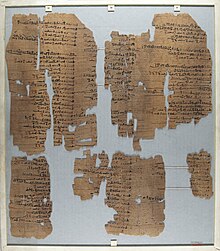| Wilbour Papyrus | |
|---|---|
 A piece of the Wilbour Papyrus in the Brooklyn Museum (c. 2010)[1] | |
| Size | length: 10 meters |
| Created | c. 1145 BC |
| Discovered | Aswan, Aswan Governorate, Egypt |
| Present location | New York City, New York, United States |
The Wilbour Papyrus, named after the New York journalist who acquired it, Charles Edwin Wilbour, is the largest known non-funerary papyrus from Ancient Egypt. It is an administrative document which contains a survey of cultivatable lands in the late Ramesside Period of the New Kingdom of Egypt. The papyrus is 10 meters long and divided into two sections, text A and text B. Text A contains an extensive account of lands both privately and collectively owned. Text B is much shorter and contains an account of exclusively royal lands.[2] The Wilbour Papyrus is a rare case of a well preserved look into the economic administration of Ancient Egypt. Egyptologists have been able to use it to produce a more complete analysis of the function of the Ancient Egyptian state.
- ^ "The Wilbour Papyrus". Brooklyn Museum. Retrieved March 1, 2023.
- ^ Cite error: The named reference
:5was invoked but never defined (see the help page).